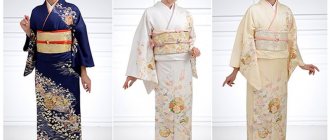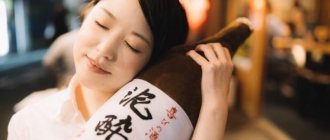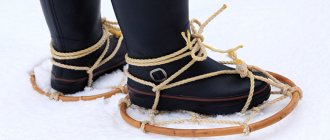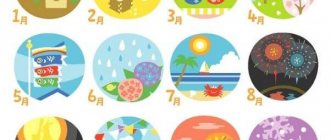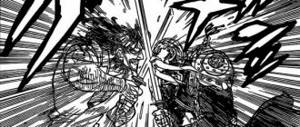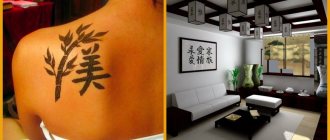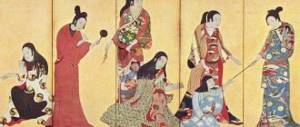Author: Varvara Lyutova
03 January 2021 11:20
Community: Facts
Tags: stories kimono fashion clothes where it came from changes in history styles evolution
8958
9
For centuries, style and fashion in Japan have been defined by one item: the kimono. It was not just a piece of clothing - it was a symbol of an entire culture, carrying symbolic meaning and embodying much more than what can be seen. Today we will try to trace the evolution of the kimono, starting from the 8th century AD, and evaluate its role in modern Japanese culture.
0
Source:
See all photos in the gallery
Style
0
Source:
Traditional kimonos differ from each other in style. Style is determined by a number of criteria - gender, marital status, event to be attended. For example, an unmarried girl will wear a furisode (“flying sleeves”) type kimolo to a formal event, and a man, a store owner, will wear a happi (a kimono, more like a jacket) to a public celebration.
Features of the cut
Kimonos are worn by both men and women in Japan. They also put it on children. This national clothing has many features, including cut. The main one is the geometric lines of the model in the shape of the letter T, which are not adjusted to a specific figure. This applies to both the length and width of the robe.
In fact, a kimono dress is a long silk wrap robe with large sleeves, which is secured with a wide obi belt with a lush bow on the back. The belt for the male version is much narrower than the female one, tied almost at the hip line. The kimono emphasizes only the shoulder line and waist of the owner, hiding the figure and masking its possible flaws. During the dressing process, the outfit is tailored to a specific person by making special folds, secured with an obi.
Japanese clothing is cut from a single piece of fabric 40 cm wide and 9 to 12 meters long. In this case, two strips out of the four cut cover the body, and the remaining two are used to make sleeves. Small stripes are used for the main and overlay collars. Two narrow stripes are cut out to decorate the right and left edges of the kimono at the front (okumi). All parts are rectangular in shape without any rounding.
A special feature of wearing a kimono is the smell on the right side. Therefore, the left front part of the dress is always on top, and the right one is inside, closer to the body.
The sleeves of the kimono look like a bag. For men it is sewn into the robe, and for women there is an axillary hole - furitsyakuchi. Sleeve length varies. For example, for an unmarried girl or a future geisha (maiko), it should be 1 m. The cut of a children's kimono is a little simpler to make it easier to put it on the baby. It looks more like a quilted robe, brighter in color than an adult's.
The materials of traditional Japanese kimono are silk and satin. Most often the fabric is painted by hand. The designs, their location, and the color of the clothing must correspond to the age, gender, position in society, and the event to which it is worn. Prints also depend on the season. For example, in winter they depict pine trees and bamboo, and in spring the kimono is decorated with sakura flowers.
Children's
Women's
Male
Color
0
Source:
The color of the kimono also has symbolic meaning, as do the pigments chosen for dyeing. “Colors embody the spirit of the plants from which they are taken,” explain the Victoria and Albert Museum. “The same applies to their medicinal properties, which are believed to be transferred to the tissue. For example, blue, obtained from the indigofera plant, is believed to repel snakes and insects.”
Additional accessories and attributes
Additions to national Japanese clothing include: special underwear, several types of kimono that are worn under the main one, an obi belt, traditional shoes, and hair decorations. To put it all on correctly, especially for a woman, you often have to resort to the help of specially trained people. They work at hairdressers, have a license, and can be called to your home. The main attributes of a traditional outfit:
- Hadajuban and sasoeke - a thin shirt and bloomers worn by women as underwear, can be combined with each other.
- Nagajuban (juban) is a long shirt, similar in cut to a kimono, worn under the outer garment to prevent sweat and dirt from the body from getting on it.
- Hakama – pleated wide-leg trousers. The women's version is in the form of a skirt.
- Haori is a special jacket worn over a kimono. Together with the hakama, it adds formality to the outfit. It is secured with a special haori-himo cord.
- Kanzashi or kanzashi - Japanese jewelry, hairpins, hairpins. The art of making kanzashi is national, handmade. Decoration motifs often echo the patterns on the kimono.
- Tabi - socks with a separated toe for the convenience of wearing zori.
- Zori - leather or fabric sandals (reminiscent of slates).
- Geta are wooden sandals worn primarily with yukata.
- Okobo are high shoes on which girls (mostly maiko or geisha) can only walk in small steps, otherwise they risk falling.
- Waraji - straw sandals - traditional shoes of priests in temples.
- Obi is a wide belt for dressing.
- Koshihimo - ties to make it easier to put on an outfit.
Waraji
Geta
Zori
Kanzashi
Obi
Okobo
Tabi
Hakama
Haori
History and evolution
0
Source:
The prototypes of the kimono, simple and easy to wear, originated in Japan during the Heian era (794 - 1192 AD). As with modern kimonos, straight pieces of fabric were used for sewing. Kimonos also accommodated all sizes and shapes. In the Edo era (1603 - 1868), this clothing was called kosode (small sleeves), the size of the sleeves was greatly reduced. Kosode played an important role during this period; they were worn by all Japanese, regardless of social status, age and gender. To express their own individuality, the Japanese began to look for a way to customize the kosode to suit themselves. During the Meiji period (1868 - 1912), kosode evolved into modern kimonos, becoming primarily women's clothing. The main function of this clothing, as now, was to convey the meanings attached to those who wear the kimono.
Classification by purpose
The Japanese robe for different sexes differs significantly in color, cut, components, and national symbolism. Men's kimono in modern Japan can come in just a few discreet dark colors: blue, black, green, brown. The fabric is used without shine, matte. The drawing can be small and printed.
A formal men's kimono must have five kamon. A dress with three coats of arms is considered less formal. Often the outfit is complemented by hakama - wide pants or a skirt, and haori - a traditional jacket over a kimono.
The decoration consists of five elements, excluding shoes. Therefore, a man can put on a kimono himself, without outside help.
A woman's kimono traditionally consists of 12 components. But in the modern world, such multi-layering is used in rare, special cases. For example, for a wedding or an important high-level official event. In everyday life, for walks, to festivals, to a restaurant, they most often wear a maximum of two layers or just a kimono with a false second collar.
The color of a woman's kimono plays an important role. The most formal is black with designs on the sleeves and below the waist. Geisha can afford to wear bright robes with scarlet lining. Young unmarried girls usually wear outfits fully embroidered with flowers in delicate shades of peach, pink, and blue. Everyday kimonos in discreet, beige, brown, and greenish shades are covered with small patterns.
Japanese clothing for small children is much simpler than for adults. This bright multi-colored robe is sometimes remade from an old women's or men's dress. It is usually quilted and does not have a complex design. For older children, for special occasions, a small copy of an adult outfit is sewn, but in a richer color scheme.
Influence on world fashion
When Japan opened up to the outside world in the 18th century, the influence of the traditions of the Land of the Rising Sun spread across it along with merchant ships.
Even today, the kimono continues to influence fashion designers around the world. Alexander McQueen is one of the biggest fans of the kimono, including it in his clothing collection.
The kimono also influenced many of the costumes in the Star Wars series, for example, and the film itself was heavily influenced by Akira Kurosawa with The Hidden Fortress. George Lucas borrowed many elements from Japanese culture and cinema, especially his clothing style.
Weaving BJJ Kimono
Single weave is the thinnest and lightest. As mentioned above, these Brazilian Jiu-Jitsu gis are positioned mainly as competition models. They are less suitable for daily training, unless, of course, you are ready to fork out for another sample soon. Yes, I agree, there are kimonos from this category that have a very long life expectancy, but as a rule this is rare.
Double weaving is the most durable option, but, as a result, the heaviest. It is noteworthy that some fighters deliberately wear such gis, believing that the supposed hardness of the lapels of such gis significantly prevents the enemy from strangling you or simply maintaining a hold. Top-end judo kimonos are usually sewn with just this kind of weaving, which is where their extremely heavy weight and density come from.
Gold braid is something of a middle ground option for those who don't want to wear a heavy gi, but at the same time don't want to sacrifice its strength. Interesting fact: gis made with this type of weave tend to shrink quickly and strongly after washing, so we advise you to seriously consider buying a slightly larger size than what you actually have.
Imperial court during the Heian era
Almost all the nobles lived in Heian-kyo, about 5 thousand families in total. The life of the aristocracy, of course, was strictly regulated: all noble families were recorded in special clan lists, each family was assigned one of thirty court ranks, and powers and privileges were assigned to each rank. The rank of a courtier could be determined by the carriage on which he rides, by the location of the house (the closer to the emperor’s palace, the more prestigious), by the color and pattern of the kimono, and even by the number of folds on the fan: those close to the emperor held fans with 25 folds, and they might not even say hello to the 20-fold simpletons.
Modern looks with a kimono
Fashion dictates new images. European girls gladly put on a trendy item - a kimono in the form of a spacious cape. Stylized dresses of varying lengths help create interesting layered ensembles. This style of clothing is well suited for women with an “apple” or “triangle” body type, as it hides imperfections. A kimono-cut cape or blouse goes well with jeans, shorts, skirts, dresses, and T-shirts. Sneakers, sneakers, sandals, pumps, and loafers fit perfectly into the look. On this basis, you can create both a business and evening look, complementing it with stylish accessories - massive earrings, a belt buckle, an original bag.
Japanese fashion designer Jotaro Saito creates modern kimonos, combining tradition with the latest developments. He uses a mix of textures, fabrics, traditional and modern patterns, interesting colors and shades in his models. Very often, modern Japanese kimonos and clothes based on them are presented by the Kenzo fashion house. In one image, fashion designers seem to combine the past and the future. All these things are always popular.
Judogi - a necessary uniform for judo
The peculiarities of judogi, as a type of judo uniform, lie in the throwing fighting technique. A wrestler's sports attire should protect him from various injuries and abrasions. To ensure this, the jacket and pants of the suit have elongated parameters. The length of the jacket is at the level of the hands, lowered along the body, it completely covers the hips. The jacket itself is quite wide - the right floor, at the level of the lower chest, wraps around the left, at least 20 cm. The sleeves are wrist-length, or can be 5 cm higher. The length of the trousers covers the ankle joint of the leg. Along the entire length of the trouser leg there is 10-15 cm of space between the leg and the trousers. There are stitched panels at the lapels, armholes and knees for durability. The material for judogi is cotton or another type of high-strength fabric, color – white, blue. The color of the 4-5 cm belt, which wraps the judogi twice tightly, corresponds to the qualifications of the wrestler.
Poetry tournaments
Aristocrats were in the emperor's service; their duties, first of all, included looking elegant, gesticulating exquisitely, playing musical instruments and mastering the art of calligraphy. For the slightest mistake you could lose your position at court. But the nobleman’s main skill is to compose poetry. Aristocrats corresponded in poetry, and poets' tournaments were held at court. The main poetic form was waka, syllabic poetry. It is found, for example, in such famous literary works as “Notes at the Bedside” and “The Tale of Genji.” At the end of the 10th century, a 20-volume anthology of Japanese poetry, Kokinwakashu, was published. At the end of the 10th century! When the first birch bark letters had not yet appeared on the territory of Rus'.
Patterns
Men's kimonos are usually made from plain fabric without any patterns. Even if they are present, they may only depict a family pattern (in Japanese tradition, some noble families have their own unique engravings passed down from generation to generation).
Women's kimonos have countless patterns to choose from. When choosing patterns for women's kimonos, preference is given to natural patterns - the most popular are patterns with flowers and birds. For example, on a sunny April day, a pink kimono with sakura petals is perfect and will emphasize the femininity and attractiveness of a woman.
Kimonos for tea ceremonies are a separate matter. They are strict and reserved.
Unlike the usual women's kimono style, women's kimonos for tea ceremonies should not be bright colors (with the exception of very young girls).
In addition, the kimono must be seasonal, so girls often do not have time to change their kimono for the season, since they have to change the kimono to a new one every two weeks.
How to wear a kimono
Tabi (white cotton socks) are worn along with traditional clothing; it is also necessary to wear underwear - hadajuban (only women use it); then the nagajuban, the lower cotton kimono. The kimono is wrapped from left to right, regardless of whether it is worn by a man or a woman. Since traditionally this garment does not have buttons, special ties and an obi, a kimono belt, are used to maintain it.
When worn, about two centimeters of the haneri (collar) of the nagayubana should protrude above the collar of the kimono. According to tradition, the collar should cover the neck, which is considered one of the most sensual parts of the female body. A loose collar that reveals where the neck meets the back can only be worn by geisha.
Samurai in the Heian era
While the courtiers were weaving intrigues and competing in poetry, feudal wars broke out in the provinces every now and then, and at the end of the 8th - beginning of the 9th century, a new military class was formed from small landowners - the samurai. Nominally they were in the service of the emperor, but, in general, they were not very good at discipline. Personal samurai honor was above all, even if issues of honor went against the orders of the command. Therefore, it was difficult to control such an army, and only particularly authoritative samurai generals succeeded. Until the 11th century, the weapon of the samurai was a bow, not a sword. And the familiar katanas appeared only in the 14th century.
Mofuku
Many modern Japanese women have lost the skill of putting on a kimono themselves: a traditional kimono contains twelve or more separate pieces, so if necessary, they often turn to specialists in this field - the otokoshi
Mofuku Kimono (喪服) or funeral kimono is worn in Japan only when someone has died . They are completely black and are worn only by those who were close to the deceased. Other people may wear certain parts of a full Mofuku ensemble, such as a belt or accessories, to show their respect. Under the black kimono, people wear white silk underwear.
The term Mofuku is used for all black (women's) kimonos. When it comes to Mofuku for men, it doesn't really exist as men wear their formal ensemble called "montsuki" for it. This ensemble is suitable for any special occasion, including funerals.
Furisode
Furisode is one of the most formal outfits a Japanese woman can wear.
At some point in history, it was a genderless garment that was also worn by boys.
They are often worn at weddings and other formal parties. This kimono is worn only by unmarried women. Long elegant sleeves make this kimono very original.
Furisod for coming of age ceremony (with hair styling)
Furisode not only has long sleeves, but all the accessories, from the obi to the handbag, are different from the usual kimono style. Every detail and way of dressing represents the most formal attire. At the coming of age ceremony, every woman who has reached the age of 20 will wear a luxurious kimono to mark her official age of majority. The Furisode kimono is the perfect option for that once-in-a-lifetime occasion. The extra material and unique design can make the Furisode expensive to purchase. As a result, many people rent kimonos from local rental stores.
Furisode sleeves are made shorter as the wearer gets older or after marriage. And some women over 30 do not wear furisode at all. Women under 30 and older sometimes wear long furisode sleeves - it has become commonplace for photo shoots and special occasions.
Japanese kimono today
Nowadays, the Japanese kimono is typically worn for more formal events, and people wearing yukata are most often seen at festivals as it is a lighter, cheaper alternative.
For more information on how and when to wear a yukata, read our article.
Sometimes kimonos are made from synthetic fabrics because silk is expensive. Some fashion designers in Japan adapted it more creatively for youth culture, and thanks to several world exhibitions, the kimono has once again become a symbol of Japan.
In the Harajuku area, you can even buy pretty cheap second-hand kimonos! So why not treat yourself and discover exactly how you'll look in this traditional outfit!
Want to learn more about Japanese culture? Read more articles from our blog.
Related materials:
Marni | Gucci | Dior | HERMES | Herm | Edun | Celine | Alexander Wang | Rochas | Isabel Marant | MM6 Martin Margiela | CHANEL | Yves Saint Laurent | kimono | Marnie | Gucci | Dior | Chanel | Yves Saint Laurent
Articles
- Technology news April 17, 2021, 00:00
- New Year's nail collection December 05, 2021, 00:00
- Feng Shui manicure: chapter two January 26, 2021, 00:00
Video
- New anti-aging care line Forever Youth Liberator from Yves Saint Laurent March 20, 2013, 18:00
- New fragrance Black Opium from Yves Saint Laurent February 03, 2015, 22:00
- A splash of radiant shades from Yves Saint Laurent July 30, 2015, 10:00
Modern Japanese traditional clothing
So, what a kimono is in the traditional sense is already clear. But today, designers and artists have rethought this concept. They have come up with unique ways to preserve Japanese heritage and showcase its beauty. Very often, the outfit is worn by models, since the kimono looks very impressive in the photo.
Apart from those kimonos worn daily by the elderly or performers of traditional arts, it is not very common these days, but is still worn on special occasions such as weddings and funeral ceremonies.
The popularity of the outfit has decreased partly due to its very high cost. Also problematic for many is the process of putting it on and tying the obi (decorative belt): all this is a complex procedure that is beyond the capabilities of many modern young women. The problem, as a rule, is connected not only with how to put on this element of the wardrobe - you also need to know how to tie a kimono. To do it right, girls must ask their mothers to help them or take a course in a special school.
Belts in Brazilian Jiu-Jitsu
For children under 15 years old, there are only five belts: white, gray, yellow, orange, green.
For students 15 and older, the belt system in Brazilian Jiu-Jitsu is: white, blue, purple (often called violet), brown, black, black-red (sometimes called coral), red-white and red.
Stripes-Stripes (stripes)
Many Brazilian Jiu-Jitsu schools and academies also use a stripe system in addition to the belt system to encourage their students to develop. They are glued with a regular plaster (tapes), the same one used to wrap your fingers during training. In fact, a belt that has scored 4 stripes is already on the threshold of a new belt certification. Getting the next one is the next step. It is worth mentioning that the presence of stripes on one athlete does not mean that his skills are higher than those of a jitter without stripes. Stripes in Brazilian Jiu-Jitsu are more of a purely motivating moment and trainers give them at their discretion. Some BJJ schools do not use this system at all.
